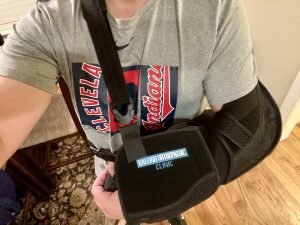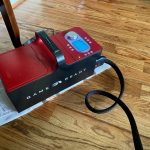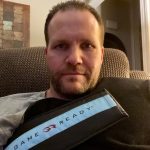Brian Schiff’s Blog
Injury Prevention, Sports Rehab & Performance Training Expert
It is that time of year where baseball pre-season throwing is ramping up. I am starting to see throwers coming in to my clinic with shoulder and elbow issues. In many cases, injury can be avoided with proper stretching and strengthening as well as effective loading programs.
Pectoralis major/minor and latissimus muscle tightness along with poor scapular control often leads to postural dysfunction and shoulder problems. Improving shoulder mobility and scapular control can reduce injury risk and shoulder strain.
The video below from one of my Functional Fit columns will demonstrate an excellent exercise that can be programmed for every thrower to aid in optimizing shoulder mobility and promoting shoulder health.
I often use this exercise following soft tissue release techniques and in conjunction with thoracic spine extension mobilization on the roller. It is an excellent warm-up and activation exercise.
Tightness in the hip flexors is very common. If you have a job that requires extensive sitting or spend lots of time cycling, this may be a problem area for you. Stiffness can limit gait mechanics and optimal movement patterns thereby putting undue strain on the lower back. Below is a simple corrective exercise that can be done routinely to help improve flexibility using a sliding disc.
As I write this update, I have now been back to work for a month. The first 3 days back were challenging, as I had not done that much with my arm in quite some time. I was sore by 5 pm each day, but no significant pain. The soreness resolved by the next morning. I quickly realized how weak I was as I attempted to stretch a client’s hamstring lifting the right leg up with my left arm.
With that said, going back to work also facilitated me moving the arm more frequently and using it against gravity. This has allowed me to regain more functional mobility and strength the past month. I have been careful to avoid any heavy or overhead lifting. I have not encountered something I could not do yet in patient care, but I have had to be aware of my body mechanics and positioning to reduce strain on the left arm.
MD follow-up
I saw the doctor this past Friday. He was pleased with my progress and encouraged me to keep working on regaining the last portion of my ROM. I will go back for one final appointment in 6 weeks. Of note, I had previously asked him to image the right shoulder to see if I had a tear since I have been having some right shoulder pain that has worsened since the left shoulder surgery. The MRI revealed a partial tear (30-40% of mostly bursal-sided fibers), some degeneration in the anterior labrum, biceps inflammation and a sizable bone spur. In essence, the doctor says I need to have the bone spur taken out in the near future to avoid a full tear on my right side. Not great news, but I am relieved it was not fully torn.
Rehab and Exercise
I am continuing to get stretched 2x/week, while doing my pulley and ROM exercises daily at home. I am performing scapular and rotator cuff strengthening about 3x/week. I returned to the gym for the first time on Labor Day. This was a humbling day to be sure as I cannot even do 50% of my previous weight with pull downs, rows and other lifts. But, Rome was not built in a day, and I know it will likely take up to a year to get back to 100% again.
For those following my rehab journey, this entry will recap days 8-14 after surgery. At this point, I had been off pain meds for 4 days. However, I will admit I took one pain pill prior to my first PT session exactly one week out from surgery. For two decades I have listened to patients recount stories of their own or friends who report how painful therapy is after this surgery. Oddly enough, most of my patients over the years said it was not so bad. Perhaps, there is great variability in the intensity of the passive stretching among therapists.
Research Nuggets
The literature offers support and caution for early motion after rotator cuff repair. While ROM is generally better early on with early motion, there is some concern about higher re-tear rates. I am in the camp that gentle early passive range of motion (PROM) is okay given the proper regimen and patient compliance. Early active range of motion (AROM) or too vigorous PROM is likely to be more detrimental to the repair. Ultimately, these decisions are made based on the size of the tear, tear configuration, patient’s health and age, MD preference and whether or not this is a primary or revision repair.
The article abstract below is a great reference for activities and activation of the rotator cuff as measured by surface EMG to provide some insight for patients and clinicians regarding safe movement and exercise in the rehab process:
https://pubmed.ncbi.nlm.nih.gov/28704624/
In addition, here is another article that outlines post-op rehab (you can download the entire article for free)
https://pubmed.ncbi.nlm.nih.gov/29399735/
My First PT Visit
So, I would be lying if I said I was not nervous. I mean I was always the guy stretching the fresh post-op shoulders, and suddenly I am the one laying on the table a week out from surgery about to let someone move my stiff, sore shoulder. Fear of the unknown is probably the worst in that moment. My therapist is a colleague in my own clinic who actually reports to me. No pressure on him, right? LOL
He and I agreed to co-pilot my rehab and map everything out through constant dialogue and feedback. He has done a good job thus far. That first day the shoulder felt like a cement block to me. It seemed like super glue was preventing it from moving much. The focus was on gentle external rotation and flexion range of motion. Both hurt, but the flexion was by far the worst for me.
After doing pendulums and the PROM with him, my routine consisted of:
- Seated passive external rotation using a cane on my own – 2 sets of 15
- Scapular retraction (gentle squeezing of the shoulder blades together) – 2 sets of 15
- Seated table slides with a towel – 2 sets of 15
- Game Ready x 15 minutes with low compression
Last week I began sharing my story about my left arthroscopic rotator cuff repair. As reminder, I had surgery on May 20. In this post, I will share more about the first week. I get many common questions like: How bad does it hurt? When can you get rid of the sling? How long is the total recovery?
The entire outpatient procedure went well. I barely remember getting an interscalene block (kudos to the anesthesiologist) and the entire operation lasted about 45 minutes. The oldest feeling is not feeling the left arm and having no control of the arm until the block wears off. The entire arm is essentially paralyzed and numb. Great for pain management to be sure, but not even being able to use the hand is inconvenient for small prehensile tasks.
I was fortunate that I did not have any adverse reaction to the anesthesia itself. I was a bit tired and groggy for the first 4-6 ours after surgery. The biggest adjustment is getting used to the sling and abduction pillow (see below)

Learning how to sit, adjust and take this off/put it on takes some getting used to. However, I quickly learned how valuable and supportive it was once the block wore off. My surgery was at 8:45 AM on a Thursday. The block wore off about 18 hours later at 3 AM. Let’s just say that aha moment was enough to get my attention.
Pain
I would say pain level was 7/10 for me. The doctor and his staff had advised me to start taking pain pills ahead of the block wearing off and I had initiated that about 8 hours after surgery. I was alternating ibuprofen every 2 hours while taking oxycodone every 4 hours. I can only imagine how much more it would have hurt if I had waited for the block to wear off.
Cryotherapy
The first 3-4 days afterward were the worst in terms of pain. Generally, pain at rest was probably 3-4/10, occasionally spiking to 9/10 if I moved the wrong way. Aside from the meds, I used cryotherapy, specifically a Game Ready, extensively (20 minutes on, 40 minutes off) 8-10 times per day the first week. I cannot say enough about how helpful this is in managing pain and inflammation.
- Game Ready unit
- Shoulder sleeve
This unit provides cold and compression, however, I would recommend low or no compression initially as your incisions will be tender, especially once the surgical dressing is removed at day 3 post-op. I sat upright in a chair and supported the elbow while using this machine. The hospital or outpatient facility will offer a polar care unit for $250, but I opted for this unit as I have used it for years in the clinic, while hearing countless patients tell me how much better it is. A 3-week rental will cost you $300, but it is well worth it.



